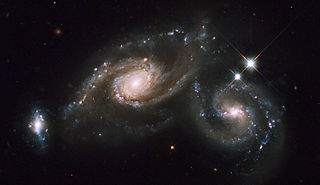
The NGC 5679 group, also known as Arp 274, is a triplet of galaxies, MCG+1-37-36, MCG+1-37-35 and MCG+1-37-34, spanning about 200000 light-years and at some 400 million light-years from Earth in the constellation Virgo. Arp 274 refers to the Atlas of Peculiar Galaxies, compiled by Halton Arp in 1966. Galaxies 269 through 274 in his catalogue are galaxies that appear to have connected arms.

NGC 2959 is an intermediate spiral galaxy in the constellation Ursa Major. Its velocity relative to the cosmic microwave background is 4,525 ± 6 km/s, which corresponds to a Hubble distance of 66.7 ± 4.7 Mpc. NGC 2959 was discovered by British astronomer John Herschel on 28 October 1831.
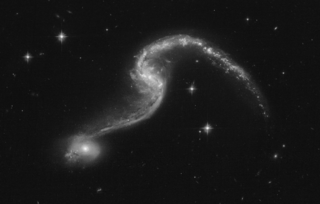
NGC 646 is a large barred spiral galaxy located in the constellation Hydrus. Its speed relative to the cosmic microwave background is 8,145 ± 19 km/s, which corresponds to a Hubble distance of 120.1 ± 8.4 Mpc. NGC 646 was discovered by British astronomer John Herschel in 1834. It forms an interacting galaxy pair.

NGC 5777 is a large edge-on spiral galaxy located in the constellation Draco. Its speed relative to the cosmic microwave background is 2,210 ± 5 km/s, which corresponds to a Hubble distance of 32.6 ± 2.3 Mpc. NGC 5777 was discovered by German-British astronomer William Herschel in 1789.
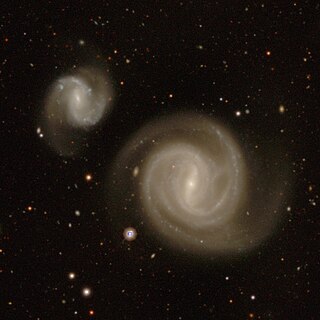
NGC 945 is a barred spiral galaxy in the constellation Cetus. It is located south of the celestial equator. It is estimated to be 200 million light-years from the Milky Way and about 135,000 light-years in diameter. Together with NGC 948, it forms a gravitationally bound pair of galaxies. In the same area of the sky there are, among other things: the galaxies NGC 942, NGC 943, NGC 950, IC 230. The Type Ib supernova SN 1998dt was observed here. The object was discovered by astronomer William Herschel on November 28, 1785. It is within close proximity to NGC 948.
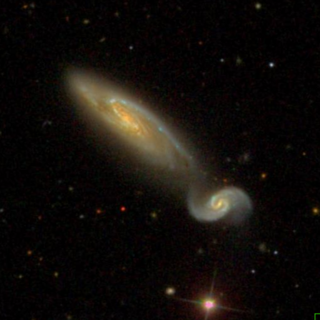
NGC 3800 is an intermediate spiral galaxy located in the constellation Leo. Its speed relative to the cosmic microwave background is 3,653 ± 24 km/s, which corresponds to a Hubble distance of 53.9 ± 3.8 Mpc. NGC 3800 was discovered by German-British astronomer William Herschel in 1784.

NGC 3799 is a barred spiral galaxy located in the constellation Leo. Its speed relative to the cosmic microwave background is 3,659 ± 24 km/s, which corresponds to a Hubble distance of 54.0 ± 3.8 Mpc. NGC 3799 was discovered by British astronomer John Herschel in 1832.
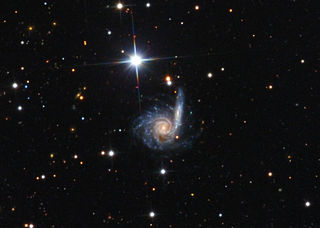
NGC 6365 is a pair of spiral galaxies in the constellation Draco. It consists of two galaxies, PGC 60174 to the south, and PGC 60171 to the north. These two galaxies are also designated respectively by the NASA/IPAC database as NGC 6365A and NGC 6365B. This pair of galaxies was discovered by German astronomer Lewis Swift in 1884.

NGC 3290 is a large and relatively distant intermediate spiral galaxy located in the constellation Hydra. Its speed relative to the cosmic microwave background is 10,937 ± 27 km/s, which corresponds to a Hubble distance of 161 ± 11 Mpc. NGC 3290 was discovered by American astronomer Francis Leavenworth in 1886.
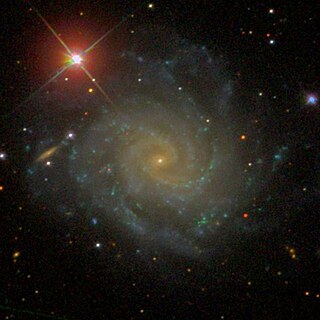
NGC 5885 is an intermediate barred spiral galaxy located in the constellation Libra. Its speed relative to the cosmic microwave background is 2,185 ± 13 km/s, which corresponds to a Hubble distance of 32.3 ± 2.3 Mpc. NGC 5885 was discovered by German-British astronomer William Herschel in 1784.

NGC 1024 is a large spiral galaxy of type Sab located in the constellation Aries. Its speed relative to the cosmic microwave background is 3,306 ± 16 km/s, which corresponds to a Hubble distance of 48.8 ± 3.4 Mpc. NGC 1024 was discovered by German-British astronomer William Herschel in 1786.
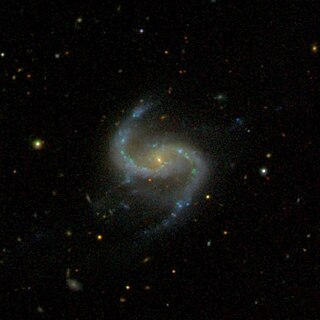
NGC 4017 is an intermediate spiral radio galaxy located in the constellation Coma Berenices. Its speed relative to the cosmic microwave background is 3,748 ± 21 km/s, which corresponds to a Hubble distance of 55.3 ± 3.9 Mpc. NGC 4017 was discovered by German-British astronomer William Herschel in 1785.

NGC 3200 is a large spiral galaxy located in the constellation Hydra. Its velocity relative to the cosmic microwave background is 3,877 ± 25 km/s, which corresponds to a Hubble distance of 57.2 ± 4.0 Mpc. NGC 3200 was discovered by American astronomer Edward Singleton Holden in 1882.

NGC 2648 is a spiral galaxy located in the constellation Cancer. Its speed relative to the cosmic microwave background is 2,451 ± 19 km/s, which corresponds to a Hubble distance of 36.2 ± 2.6 Mpc. NGC 2648 was discovered by German-British astronomer William Herschel in 1784.

NGC 2937 is an elliptical galaxy located in the constellation Hydra. Its velocity relative to the cosmic microwave background is 105.1 ± 7.4 km/s, which corresponds to a Hubble distance of 105.1 ± 7.4 Mpc. NGC 2937 was discovered by German astronomer Albert Marth in 1864.

NGC 4674 is an edge-on barred spiral galaxy located in the constellation of Virgo. Its velocity relative to the cosmic microwave background is 1,846 ± 44 km/s, which corresponds to a Hubble distance of 27.23 ± 2.09 Mpc. NGC 4674 was discovered by British astronomer John Herschel on 5 May 1836.

NGC 1585 is a spiral galaxy in the constellation of Caelum. Its velocity with respect to the cosmic microwave background is 4,635 ± 31 km/s, which corresponds to a Hubble distance of 68.4 ± 4.8 Mpc. It was discovered by British astronomer John Herschel on 1 December 1837.

NGC 5626 is a lenticular galaxy in the constellation of Hydra. Its velocity with respect to the cosmic microwave background is 7,120 ± 20 km/s, which corresponds to a Hubble distance of 105.0 ± 7.4 Mpc. It was discovered by British astronomer John Herschel on 30 March 1835.

NGC 3447 is a barred Magellanic spiral galaxy located in the constellation Leo. Its speed relative to the cosmic microwave background is 1,405 ± 34 km/s, which corresponds to a Hubble distance of 20.7 ± 1.5 Mpc. It was discovered by the British astronomer John Herschel in 1836.

NGC 3187, also known as HGC 44D, is a large barred spiral galaxy located in the constellation Leo. Its velocity relative to the cosmic microwave background is 1,901 ± 22 km/s, which corresponds to a Hubble distance of 28.0 ± 2.0 Mpc. NGC 3187 was discovered by Irish physicist George Stoney in 1850.





















